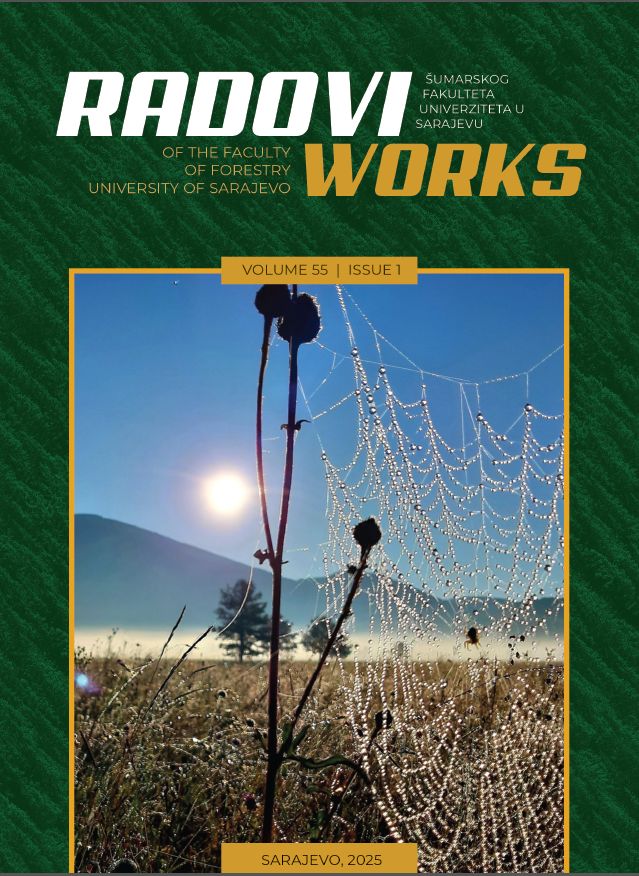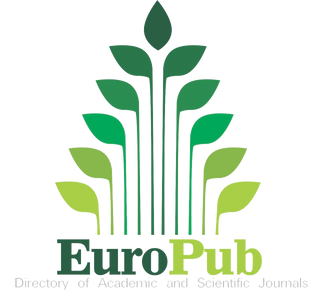The manner and frequency of using the green area of the Stojčevac excursion site in Ilidža
DOI:
https://doi.org/10.54652/rsf.2025.v55.i1.600Keywords:
manner, frequency, green area, Stojčevac, excursion site, IlidžaAbstract
This paper presents the manner and frequency of using the green area of the Stojčevac excursion site in Ilidža. The aim of the research is to determine the attitudes of visitors to the Stojčevac excursion site regarding the manner and frequency of using the green areas. The research was conducted through a questionnaire of quantitative type, in period from September 1, 2023 to October 30, 2023. The total number of respondents is 155, of which 53% are female and 47% are male. As the best rated content (grade very good) the majority of respondents state the quality of greenery (56.7%). Most respondents have a positive attitude toward additional legal protection of the Stojčevac excursion site (80%). The results of this research will expand the existing knowledge about the satisfaction of visitors to the Stojčevac excursion site, and contribute to experts in solving problems in finding the possibility of protection and preservation of this green area.
References
Brajić, A. (2011): Utvrđivanje zahtjeva posjetilaca prema javnom gradskom zelenilu – studij slučaja „Vrelo Bosne“. Master rad, Šumarski fakultet Univerziteta u Sarajevu, Sarajevo.
Brajković (2016): Primjena rezultata ankete posjetitelja u Javnoj ustanovi Nacionalni park „Krka“. Diplomski rad, Veleučilište u Šibeniku, Šibenik.
Derkzen, M. L. (2012): Experiencing the Urban Green Space: An exploratory study of visiting behaviour, perceptions and preferences in the urban green spaces of São Paulo, Brazil. Master thesis, Faculty of Geosciences, Department of Innovation and Environmental Sciences, Utrecht University.
Ferić (2016): Etika u oblikovanju urbanih prostora. Diplomski rad, Sveučilište Josipa Jurja Strossmayera u Osijeku, Poljoprivredni fakultet, Osijek.
Gabrieli, M.; Wilson, R. (2010): The Royal Parks. Park research report 2009 ‒ all parks combined, Synovate Ltd.
Galečić, N. (2016): Evaluacija upotrebnog potencijala parkova Beograda u funkciji operacionalizacije procesa pejzažnog projektovanja. Doktorska disertacija, Šumarskifakultet Univerziteta u Beogradu, Beograd.
Gehl, J. (2008): Life Between Buildings: Using Public Space. 6th Edition, Island Press, Exeter, United Kingdom.
Hadžidervišagić, D.; Avdić, J. (2020): Način i učestalost korištenja parkovske baštine na primjeru Banjskog parka Ilidža. Radovi Šumarskog fakulteta Univerziteta u Sarajevu, Vol. 50, No. 2, Sarajevo, str. 39-48. https://doi 10.54652/rsf.2020.v50.i2.347
Hadžidervišagić, D. (2018): Pejzažno-arhitektonska i istorijska analiza Banjskog parka Ilidža kod Sarajeva ‒ koncept razvoja. Doktorska disertacija, Šumarski fakultet Univerziteta u Sarajevu, Sarajevo.
Hadžidervišagić, D. (2011): Sociološki aspekti urbanih zelenih površina u Sarajevu. Šumarstvo, UŠIT Srbije, God. LXIII, Br. 1-2, Beograd, str. 71-81.
Jim, C. Y.; Chen, W. Y. (2006): Recreation-amenity use and contingent valuation of urban greenspaces in Guangzhou, China. Landscape and Urban Planning, Vol. 75, No. 1-2, pp. 81-96. https://doi.org/10.1016/j.landurbplan.2004.08.008
Konijnendijk, C. (2008): The Forest and the City: The Cultural Landscape of Urban Woodland. Springer, New York.
Lee, Y-C.; Kim, K-H. (2015): Attitudes of Citizens towards Urban Parks and Green Spaces for Urban Sustainability: The Case of Gyeongsan City, Republic of Korea. Sustainability, 7 (7), pp. 8240-8254. https://doi.org/10.3390/su7078240
Mišetić, A. (1997): Socijalne značajke Rive u životu grada - primjer Splita. Društvena istraživanja, God. 6, Br. 1 (27), Zagreb, str. 71-87.
Muratović, E. (2021): Analiza stanja i koncept razvoja parka kod Druge gimnazije (Park Svjetlosti) u Sarajevu, Magistarski rad, Šumarski fakultet Univerziteta u Sarajevu, Sarajevo.
Nagy, K. (2002): Public Use of the Public Parks and Protected Areas of Budapest. In A. Arnberger, C. Brandenburg, A. Muhar (Eds.), Monitoring and Management of Visitor Flows in Recreational and protected Areas, Vienna, pp. 271-276.
Oguz, D. (2000): User surveys of Ankara's urban parks. Landscape and Urban Planning, Vol. 52, No. 2-3, pp. 165-171. https://doi.org/10.1016/S0169-2046(00)00130-4
Schipperijn, J. J. (2010): Use of urban green space. PhD thesis, Forest & Landscape Research No. 45- 2010, Forest & Landscape Denmark, Frederiksberg.
Stanić, S.; Buzov, I. (2014): Značenje zelenih prostora u životu grada. Godišnjak Titius, God. 6-7, Br. 6-7, Split, str. 137-153.
Šačić, D. (2021): Valorizacija i revitalizacija Malog parka u Sarajevu, Magistarski rad, Šumarski fakultet Univerziteta u Sarajevu, Sarajevo.
Vitasović Kosić, I.; Aničić, B. (2005): Investigation of Sociological Aspects of the Park Maksimir. Journal Central European Agriculture, Vol. 6, No. 1, pp. 77-84.
Yilmaz, S.; Zengin, M.; Demircioglu Yildiz, N. (2007): Determination of user profile at city parks: A sample from Turkey. Build Environment 42 (6), pp. 2325-2332. https://doi.org/10.1016/j.buildenv.2006.05.001
*** Zakon o proglašenju Spomenika prirode „Vrelo Bosne“, (“Službene novine Kantona Sarajevo”, br. 16/06) – Prečišćen tekst



















